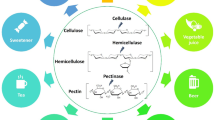Abstract
The enzymatic hydrolysis of cellulose has potential economical and environment-friendly applications. Therefore, discovery of new extremophilic cellulases is essential to meet the requirements of industry. Penicillium citrinum (MTCC 6489) that was previously isolated from soil in our laboratory, produced alkali tolerant and thermostable cellulases. Endoglucanase and filter paper activity hydrolase (FPAse) production of P. citrinum were studied using wheat bran substrate in solid state and submerged culture. Zymogram analysis of endoglucanase revealed the presence of two isoforms differing in molecular weight. One of them was 90 kDa and other one was 38 kDa. Partially purified endoglucanase showed two different peaks at pH 5.5 and 8.0, respectively, in its pH optima curve. But FPase showed only one peak (at pH 6.5) in its pH optima curve. Cellulase of P. citrinum is thermostable in nature. The present work reports for the first time, the alkali stable cellulase from alkali tolerant fungus Penicillium citrinum. Thermostable endoglucanase from P. citrinum may have potential effectiveness as additives to laundry detergents.






Similar content being viewed by others
Abbreviations
- CMC:
-
Carboxymethyl cellulose
- DNS:
-
Dinitrosalicylic acid
- FPA:
-
Filter paper activity hydrolase
- PDA:
-
Potato dextrose agar
- SDS-PAGE:
-
Sodium dodecyl sulphate polyacrylamide gel electrophoresis
- DTT:
-
Dithiothreitol
- FPA:
-
Filter paper activity
- EDTA:
-
Ethylenediaminetetraacetic acid
- SSF:
-
Solid substrate fermentation
- SSC:
-
Solid substrate culture
- SF:
-
Submerged fermentation
References
Beguin P, Aubert JP (1992) Cellulase. In: Lederberg J (ed) Encyclopedia of microbiology 1, Academic Press, New York pp 467–477
Bhat MK, Hazlewood GP (2001) Enzymology and other characteristics of cellulases and xylanases. In: Bedford M, Partridge G (eds) Enzymes in farm animal nutrition. CABI, Bradford, pp 11–57
Sreenath HK, Yang VW, Burdsall HH, Jeffries TW (1996) Toner removal by alkaline-active cellulases from desert Basidiomycetes. In: Jeffries TW, Viikari L (eds) The enzymes for pulp and paper processing. American Chemical Society, Washington, pp 267–279
Horikoshi K (1999) Alkaliphiles: some applications of their products for biotechnology. Microbiol Mol Biol Rev 63:735–750
Ito S (1997) Alkaline cellulases from alkaliphilic Bacillus: enzymatic properties, genetics and application to detergents. Extremophiles 1:61–66
Liming X, Xueliang S (2004) High-yield cellulase production by Trichoderma reesei ZU-02 on corncob residue. Bioresource Technol 91:259–262
Antony T, Chandra RK, Rajendran A, Gunasekaran P (2003) High molecular weight cellulase-free xylanase from alkali-tolerant Aspergillus fumigatus AR1. Enzyme Microb Technol 32:647–654
Tisi LC, White PJ, Squirrell DJ, Murphy MJ, Lowe CR, Murray JAH (2002) Development of thermostable firefly luciferase. Anal Chem Acta 457:115–123
Maheshwari R, Bharadwaj G, Bhat MK (2000) Thermophilic fungi: their physiology and enzymes. Microbiol Mol Biol Rev 64:461–468
Dutta T, Sengupta R, Sahoo R, Sinha Ray S, Bhattacharjee A, Ghosh S (2007) A novel cellulase free alkaliphilic xylanase from alkali tolerant Penicillium citrinum: production, purification and characterization. Lett Appl Microbiol 44:206–211
Dutta T, Sahoo R, Sengupta R, Sinha Ray S, Bhattacharjee A, Ghosh S (2007) Probing the active site environment of alkaliphilic family 11 xylanase from Penicillium citrinum: evidence of essential histidine residue at the active site. Enz Microbial Technol 41:440–446
Mandels M, Hontz I, Nystrom J (1974) Enzymatic hydrolysis of waste cellulose. Biotecnol Bioeng 16:1471–1493
Miller GL (1959) Use of dinitrosalicylic acid reagent for determination of reducing sugar. Anal Chem 31:426
Ghose TK (1987) Measurement of cellulase activities. Pure Appl Chem 59:257–268
Bradford MM (1976) A rapid and sensitive method for detecting microgram amounts of protein utilizing the principle of protein–dye binding. Anal Biochem 72:248–254
Coral G, Arikan B, Naldi MN, Venmez HG (2002) Some properties of crude carboxymethyl cellulase of Aspergillus niger Z10 wild-type strain. Turk J Biol 26:209–213
Ilme NM, Saloheimo A, Onnela ML, Penttila ME (1997) Regulation of cellulase gene expression in the filamentous fungus Trichoderma reesei. Appl Environ Microbiol 63:1298–1306
Xu B, Hellman U, Ersson B, Janson JC (2000) Purification, characterization and amino acid sequence analysis of a thermostable low molecular mass endo β-1,4 glucanase from blue mussel, Mytilus edulis. Eur J Biochem 267:4970–4977
Damaso MCT, Andrade CMMC, Pereira N (2002) Production and properties of cellulase free xylanase from Thermomyces lanuginosus IOC-4145. Braz J Microbiol 33:333–338
Nibawe S, Kuhad RC (2005) Use of xylan rich cost effective agro-residues in the production of xylanase by Streptomyces cyaneus SN32. J Appl Microbiol 99:1141–1148
Picart P, Diaz P, Pastor FIJ (2007) Cellulases from two Penicillium sp. strains isolated from subtropical forest soil: production and characterization. Lett Appl Microbiol 45:108–113
Jørgensen H, Eriksson T, Börjesson J, Tjerneld F, Olsson L (2003) Purification and characterization of five cellulases and one xylanase from Penicillium brasilianum IBT 20888. Enzyme Microb Technol 32:851–861
Anwar MN, Suto M, Tomita F (1996) Isolation of mutants of Penicillium purpurogenum resistant to catabolite repression. Appl Microbiol Biotechnol 45:684–687
Kang MK, Maeng PJ, Rhee YH (1996) Purification and characterization of two xylanases from alkalophilic Cephalosporium sp. strain RYM-202. Appl Environ Microbiol 62:3480–3482
Raghukumar C, Muraleedharan U, Gaud VR, Mishra R (2004) Xylanase of marine fungi of potential use for biobleaching of paper pulp. J Ind Microbiol Biotechnol 31:433–441
Acknowledgments
The authors like to thank the Council for Scientific and Industrial Research, Government of India, for funding this research project.
Author information
Authors and Affiliations
Corresponding author
Rights and permissions
About this article
Cite this article
Dutta, T., Sahoo, R., Sengupta, R. et al. Novel cellulases from an extremophilic filamentous fungi Penicillium citrinum: production and characterization. J Ind Microbiol Biotechnol 35, 275–282 (2008). https://doi.org/10.1007/s10295-008-0304-2
Received:
Accepted:
Published:
Issue Date:
DOI: https://doi.org/10.1007/s10295-008-0304-2




